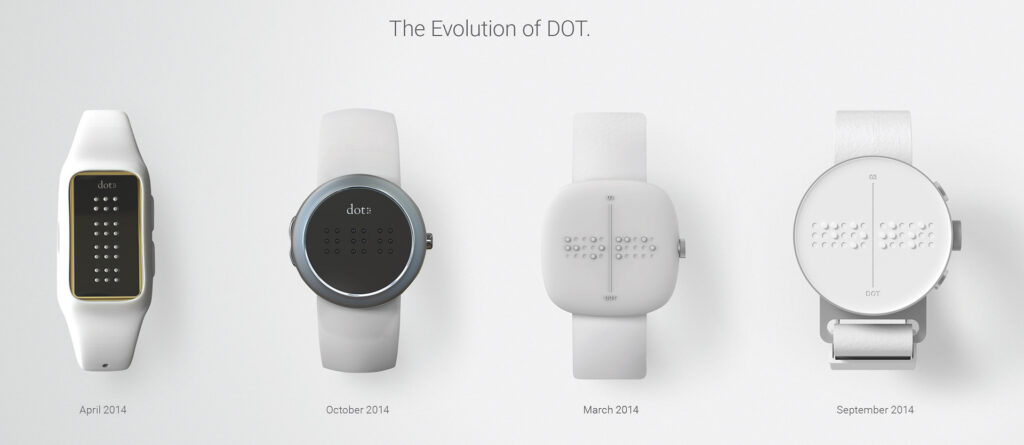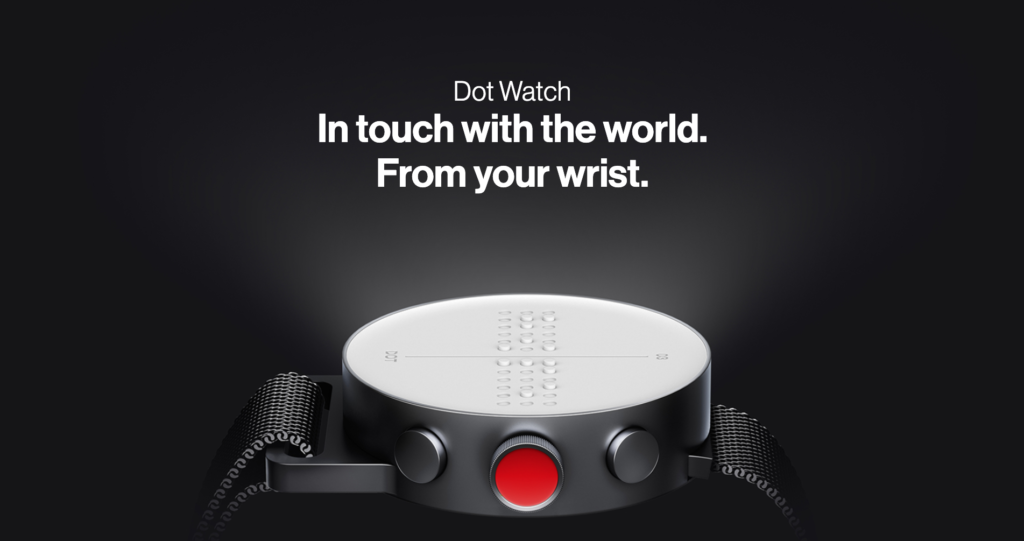The Dot Watch is the world’s first fully braille smartwatch to assist people with visual impairments. This assistive technology developed by Dot Inc. aims “to make the visually impaired get the necessary information more easily, conveniently, and quickly”. The watch features include notifying the user about who’s calling, relaying text messages to the watch face in braille, giving directions etc.

When you think about it there are hundreds of assistive technology devices for people who have visual impairment for example: screen readers, EnChroma color blind glasses, iBill and Sense Five just to name a few. What really sets the dot watch apart is that it lets the user feel the same emotions as everyone else while reading a text or getting a call from their loved ones. By letting the user read personal texts in their own space without informing everyone around them (like a screen reader without earphones would!) about the contents of the message, the dot watch affords the user his right to privacy, which in fact touches on the human rights model of disability.

Being a watch, the key feature of this product is to communicate the time. The dot watch allows the people with visual impairment to experience time in a completely new way “by themselves” (without sound). It not only tells the time but also gives direct access to all the pragmatic features that one might need throughout the day, including time & date, timer, alarm and stopwatch.
Since it is not just a standard but a “smart” watch, it also provides additional features like caller recognition, picking up/ declining calls, displaying notifications and navigation. Navigating through the busy streets of New York is not only challenging but also frustrating sometimes. As I go up and down the avenues looking at the maps on my smartphone to guide me through the chaos, I can’t help but wonder how difficult it would be for someone to find their way without this crucial piece of technology. Even though smartphones offer a whole range of navigational capabilities for people with visual impairment they are not accessible in loud surroundings (like the streets of New York City), subscribing it to the social model of disability. This is where the dot watch comes into play, it helps the people with visual impairment navigate their way through new places with ease, even if the streets get loud. It notifies the user about the bus/ subways timings directly from the apps or if the flight gate has been changed. The only catch here being that the watch depends on the apps to provide the most updated information.
In addition to being “smart”, the dot watch also acts as a braille dictionary, which means that the user doesn’t need to memorize all the braille characters and contractions. All ADA signage requires grade 2 braille – which was introduced as a space saving alternative to original braille, making it difficult for many original braille readers to comply with. This ties into the social model of disability, because grade 2 braille is primarily distinguished by its space saving component. The dot watch overcomes this by providing a simple, intuitive and entertaining braille learning program for people willing to learn the language. In order to become a truly accessible product dot also offers a tactile mode which is “usable by people with the widest range of capabilities“. Some might advocate that this product also touches on the both the medical and functional solution models of disability as well, but I don’t completely agree with that as it is not just a specific piece of technology that address a very specific task, rather it addresses an array of problems that people with visual impairment face daily. That being said, the only thing that I feel would stop this product from being accessible to the users is affordability. The watch itself costs around $299, which can be a lot for some users considering there are cheaper alternatives with a screen reader available on the market.

In conclusion the dot watch is a brilliant piece of technology that can help people with visual impairment and fulfills accessibility characteristics like utility, usability and compatibility. It not only translates and relays messages in braille but also educates the user about the latest braille standards, reducing the cognitive load for the user to remember all the braille characters and contractions. All the while complying with the ADA guideline of using grade 2 braille. It strikes a perfect balance between aesthetics and functionality, and weighs only about 1 ounce(29 grams).
References:
https://www.dotincorp.com/page/31?gbn2=Dot+Watch
http://www.e-accessibilitytoolkit.org/toolkit/product_development_and_design/accessible_product
https://www.amazon.com/DOT-Watch-Braille-Bluetooth-Smartwatch/dp/B078BNRQQ3/ref=cm_cr_arp_d_product_top?ie=UTF8
